The most important thing is that the Minelab Go-Find was not suited to be a Garrett ACE killer. Is it for good or bad… For Garrett it’s probably not important any more. Is a new Garrett ACE AT coming soon? An underwater one?
What I don’t like most about the Minelab Go-Find 40 (and the Go-Find 20/60, too) is an armrest… To put it straight, the latter is absent in the Go-Find. A fixing strap serves as an armrest.
I have repeatedly pointed out: it’s impossible to hunt with the Go-Find without this strap. Never thought the day would come when I say the Garrett ACE 250 has a good armrest… Believe me, after the Go-Find, the ACE armrest will seem to be the pinnacle of comfort.
I personally try not to use the fixing strap. The signal sounds every few minutes and I need to dig a hole. While digging up, I put the metal detector aside (we have such soils that it’s impossible to dig with one hand or foot). And when you constantly put the device aside, it’s inconvenient to get the arm out of this strap as well as tuck it into the latter again. If the armrest holds the arm without a fixing strap, it’s a real plus for me. The ACE 250 armrest does hold the arm, whereas the Go-Find one doesn’t.
How Minelab praised its new detector construction! Lightweight, requiring no assembly, convenient… It’s all these things that are the weakest point of the Go-Find.
I have two Minelab Go-Find machines, bought with my own money, in my personal zoo of metal detectors and I certainly don’t want to break them in the first months.
The thing I most worry about is plastic camlocks. Besides the fact that they are made of plastic and always ready to break down, the upper shaft is made like a trough that accumulates all trash while hunting. After the hunt (particularly at the beach), when folding up the Go-Find I have to be careful that the catches and grooves are clean. There had already been such a crunch a couple times that I thought the ‘Dark Prince’ had already come to lay the Go-Find to rest.
I can assemble and disassemble my Garrett ACE 250 with my eyes closed in a matter of seconds. And that’s what usually happens: while assembling the detector you already let your eyes rove around the field… And I have never been nervous about this process. But the fact that the Minelab Go-Find doesn’t require any disassembly is also a plus (even for me).
Two examples of disappointing grips… The Garrett ACE 250 grip is a bit thin as for an adult’s hand, the foam grip starts spinning in course of time. But it’s convenient for one-hand control as I can reach all buttons with my thumb.
The Minelab Go-Find 40 handle is of normal thickness and almost doesn’t slide in the hand. Its main disadvantage is height. With such a height, the metal detector held in hand is swaying. So you start to adjust the fixing strap (on the armrest) tighter. And the tighter the strap, the more difficult then it is to get an arm out as well as tuck it into this strap.
That’s how, due to such grips-handles-armrests, you come to an understanding of classical S-shaped shaft. The handle when released on the straight shaft requires a good balance. There is no such a balance in the Minelab Go-Find 40. The only thing that saves the situation is weight (the Go-Find weighs 1 kg), supposing it weighed a bit more, you wouldn’t walk all day long with it.
The Minelab Go-Find has a real advantage: the coil cable is hidden inside the shaft. And no matter how good you are at wrapping the cable (with no loops). The advantage is that the detector’s height can be easily changed.
If it is possible to quickly change the height of the machine, I grab this opportunity. When on hillocks I adjust the height by sliding the shaft up, for flat areas – by sliding it down, thereby increasing my search speed. If the arm gets tired, I slide the shaft up again. The same goes for ploughed field: here a bit longer and there a bit shorter. If you have your coil cable wrapped around the shaft, any change of height requires cable rewinding. Otherwise there will be loops. And walking with dangling loops is a sign of absence of hunting practice.
Anyone, who at least once has gone out on these fields with the plants sticking up out of the soil, quickly comes to an opinion that a dangling loop is bad for him.
In this regard the Minelab Go-Find 40, with its cable hidden inside the shaft, is an order of magnitude higher than the Garrett ACE 250.
Both metal detectors are powered by 4 AA batteries. Soon it will be a disadvantage as there appeared the new products powered by 2 AA batteries only. And they demonstrate the same operation time at that (for instance, the Fisher F44 – 2 AA batteries, 40 hours of operation time). Until then, that’s also normal.
I’ve noticed the fact that the batteries, which stopped working in the Minelab Go-Find 40, gave additional 1.5 hours of search when inserted into the ACE 250.
What I like about the Minelab Go-Find is a screen. Maybe my Garrett ACE 250’s screen has grown dim by the lapse of time (I doubt that), but the Go-Find screen is cool. A contrasting one, with large signs and symbols, everything can be seen perfectly (you needn’t strain your eyes).
Do the Garrett ACE 250 buttons look outdated? Maybe so, the metal detector is more than 10 years old. But the buttons work as they should. So it’s convenient (and reliable) to control the Ace machine.
The Minelab Go-Find 40 has touch buttons… I still can’t understand where the catch is. Frankly speaking, when I learned of it, the first thing that occurred to me was: and how will they respond when I am wearing a glove? Thus I’ve tried different gloves – rag and rubberized ones (except for mittens), the buttons do respond.
I haven’t used the Bluetooth feature of the Go-Find. When on a hunt, I’m engaged in hunting and tinkering around with a phone besides is not for me. Furthermore, I am a programmer and have paranoia: I know for what purpose all these apps are made.
However, I got to make use of the Minelab Go-Find backlight… Have you ever gone out for a hunt early in the morning? We went out on one field for one week since 3:00 am, and as it happened, I tested this Go-Find with another coil. So I appreciate the backlight, it’s a good thing.
Year 2015: The egg-shaped and square coils are added to traditional elliptical and round ones.
Why Minelab has made a square coil, as I understood, is a philosophical question… I haven’t noticed any practical advantage. Plus, in soil the Go-Find 40 coil is losing out to the original one of the ACE 250 in depth. But it should be the opposite: the Minelab Go-Find 40 coil is 0.5 inch larger than the Garrett ACE 250 coil.
I was concerned that these cells on the coil crossbars would become clogged up with soil, thereby increasing the coil weight and making even false signals possible… But they don’t become clogged up, everything is ok.
The Garrett ACE 250 has long proved its effectiveness and become the real classics in the history of metal detectors. Will the Mibelab Go-Find 40 make its mark in this history? There are doubts. And not because it’s some detector with a difference. The machine is searching somehow and didn’t fall to pieces on first hunts (I mean the hunts of mine). But the way Minelab dished it up is destructive for treasure hunting magic.
That’s just what they are – cheap metal detectors. For more information about the Garrett ACE 250 and Minelab Go-Find 40, see the Encyclopedia pages. There you will find everything: photo reviews, tests, videos, coils and things (ACE 250, Go-Find 40).
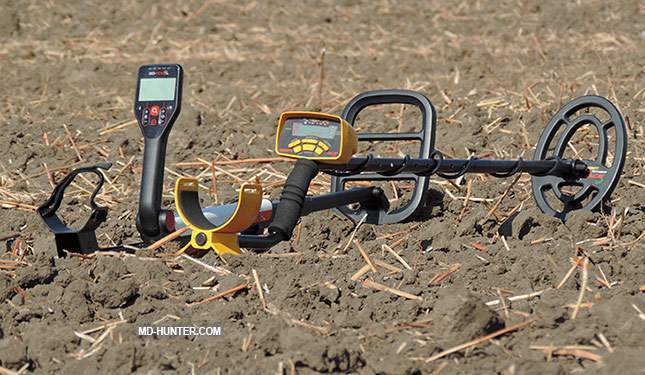
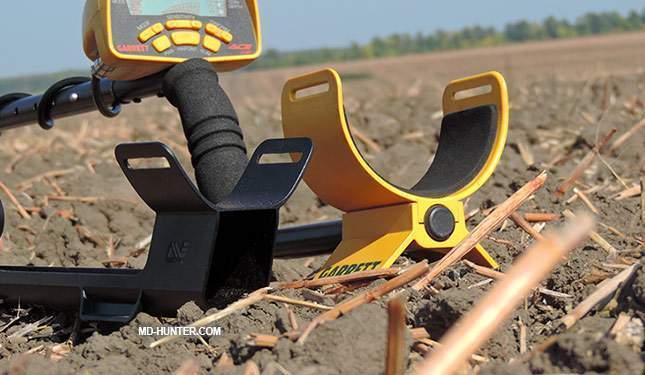
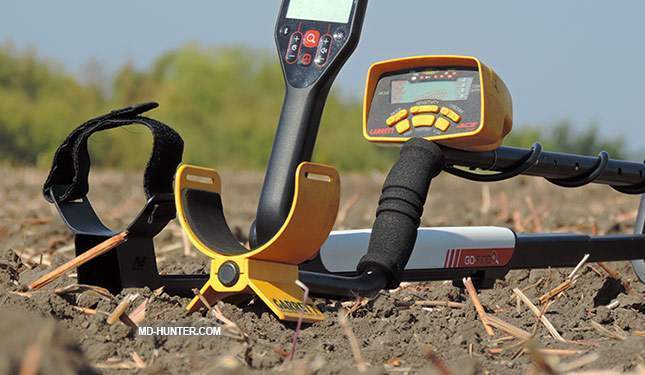
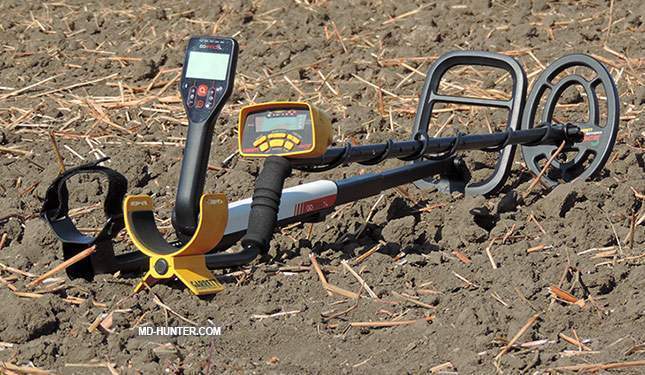
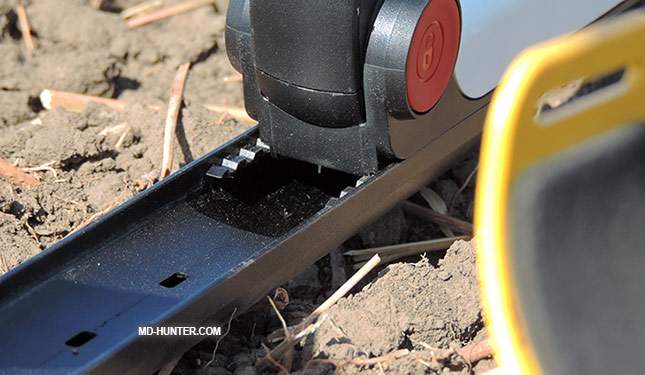
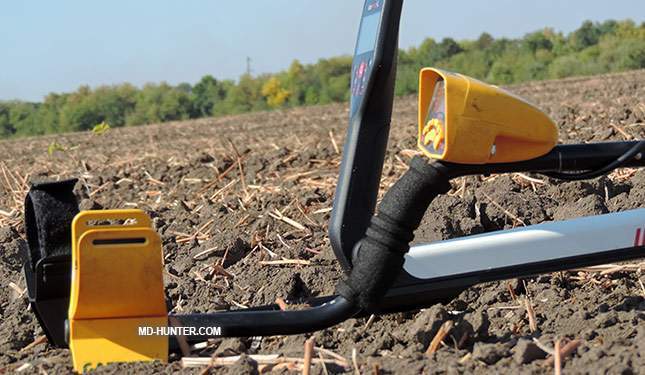
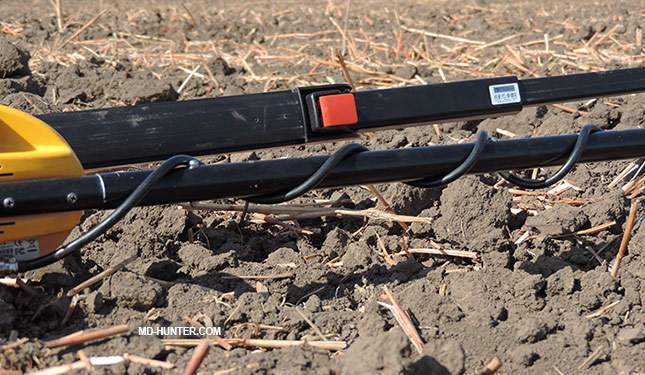

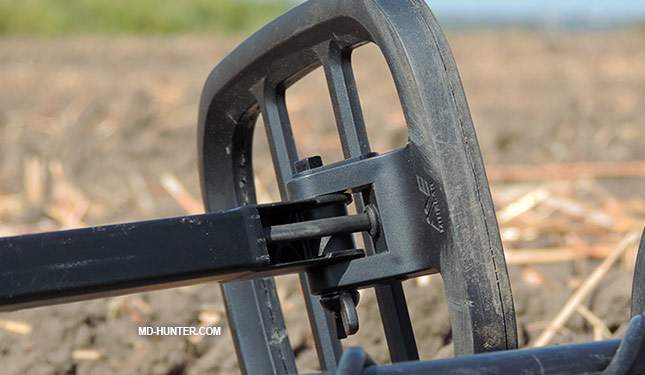
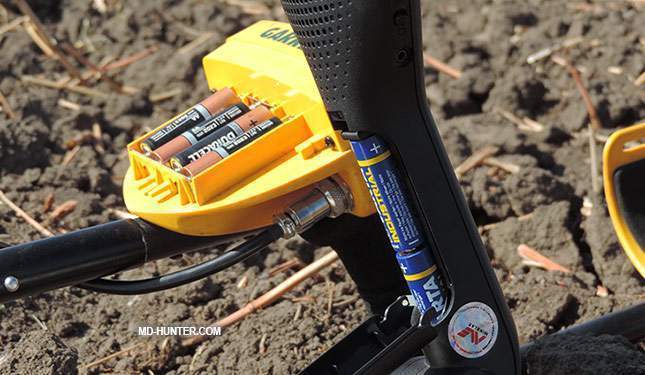
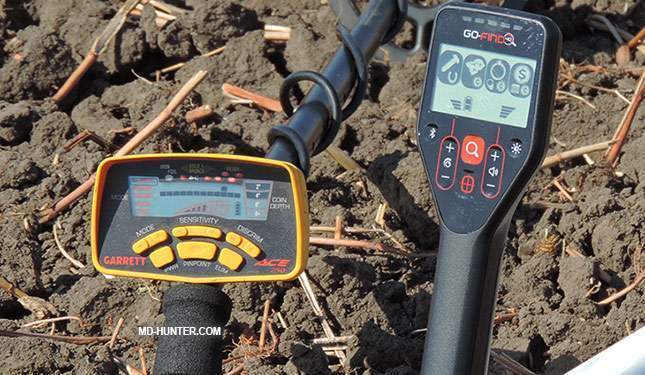
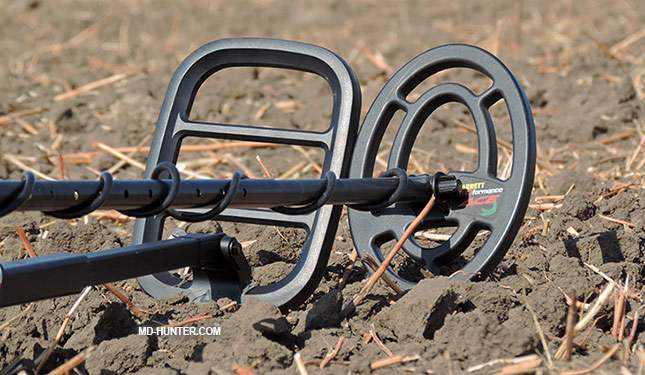
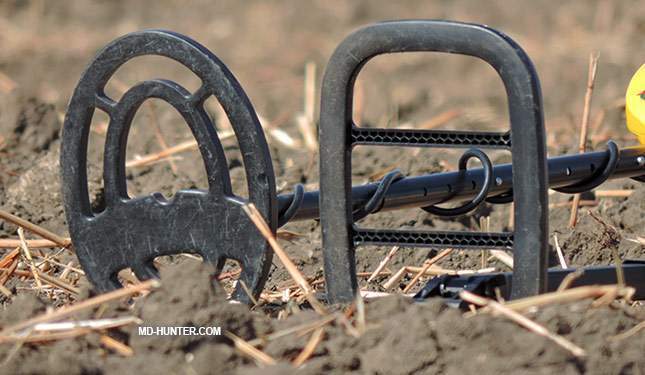
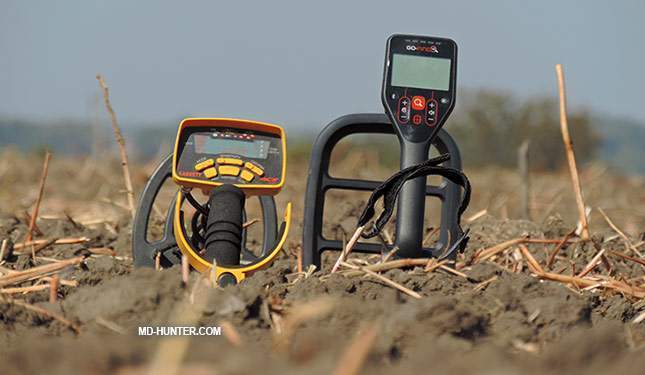

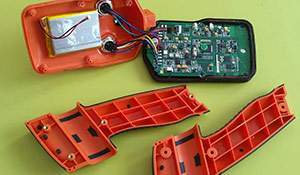
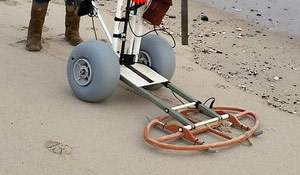
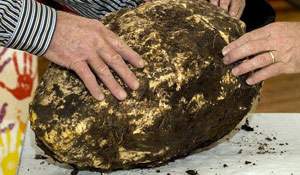




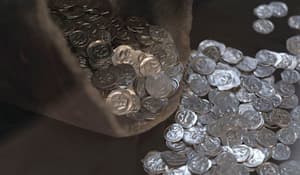

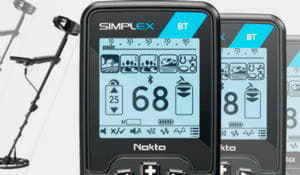
Why do I consider the Garrett ACE and Minelab Go-Find to be insufficient detectors? At least because of this…
And now compare how the Garrett AT PRO copes with this task (in the PRO mode, of course, as the STD mode puts the AT PRO down to the level of low-end machines… do not use the AT PRO in the STD mode!).
MD, can you tell me why all the videos I see of people showing nails around the coin in the recovery or discriminate tests always end up precisely laying the nails length wise along the swing of the coil? And the coin precisely in between two in this fashion as you have here in these videos.
How often is the iron junk laying so precisely out in the field? Just drop the stuff on the ground and run the test in whatever way it lays out. I have seen how some machines can’t even detect some objects at certain angles. So do you lay them out like this just for repeatable comparison sake, or are people trying to help their detectors work better on video?
Thanks for your review, a couple of minor comments which may have been overlooked. Having both detectors, the ACE 250 bought first and more recently the Go-find 40.
1, I travel quite a bit, and get to dirt fish when I can, and really appreciate the convenience factor of the Go-find series and how compact it is, just ideal for travel.
2, The Go-find 40 comes with an app, which provides more extensive info on targets.
3, You must have had better experience than me in a competitive hunt, as I have found the ACE 250 to be unusable because it interferes too much with other detectors.
4, The Go-find has auto-ground balancing.
Other that these items, I largely agree with your comments, just wish the go-find had other coil options. Will be watching out for this.
At the end of the day, the ACE 250 has proved itself as a great 1st detector, and contractors detector for locating boundary lines and irrigation valves.
The Go-find series may well distinguish itself as one of the better overall design form factor at a great price, almost 10% cheaper than the ACE 250.
Look this https://www.facebook.com/I-have-Minelab-go-find-40-456934187850656/
I really appreciate hearing this opinion on the Go Find series as I really think I’ll end up ordering one for the amount of features, the portability, and most of all it comes with all that for cheaper than most. I would probably already have one if they didn’t just “sort of” come out with upgraded versions. Now I’m waiting to get details about those. It sounds like it’s no question that most people critical about them hate the flimsy plastic construction and not having coil options. Aside from that, how are they not great starter units at that price.
If I offered a retrofit kit for these, and or upgraded units with carbon fiber and solid connections, and let’s say using an Xterra’s coil connector, would people buy it? I think they might. Doesn’t the Xterra use the same Vflex? The Xterra 705 dual pac offers two coil options. But an Xterra 705 raw costs 500 and up.
One question for you. Why the Go Find 40 and not the 60? Was it just the difference in money or something else? I’ve read that a lot of people chose the 40. At least the most outspoken ones.
This is old but I just played with some. People went or go with the now 44 over the 66 because of price point. Main difference was price but I noticed the 40 or 44 or even the National Geographic version in this aspect seemed like it was basically the same as the 60 or now 66 without the ability to reach full sensitivity and missing a tone. It is like they just have it turned slightly down. Like it should hit deeper with a weaker signal but no weak or faint signal. When it hits it hits strong. The 60 and or 66 have higher sensitivity settings allowing the deeper weaker signal also has one more tone than the 40/44.
I was hoping they had but wasn’t expecting an old-school internal onboard pot to adjust but I saw on the teardown on this site that it did not.
I had picked up a really cheap $30 used National Geographic branded model is what got me interested. It is Go Find 40 without a couple options like led signal lights, but the LEDs could be added to the board, since they used the same boards. The plastic face plate even has the lights holes under the NatG face decal. The control pad has the buttons and same control pad for the sad Bluetooth not incorporated but the blister button with ribbon cable is there under the pad. I set them aside for now and will revisit them some other time when I am going to try and figure out how to ad the depth to the NatG, 40 and 44 versions copying the 66 as much as I can. Not so much adding the Bluetooth. That wasn’t exactly what it should or could have been. I haven’t put them under the microscope yet.
Anyway what I am getting at for anyone interested in the Go Find as an inexpensive get you out their and going small light MINELAB metal detector on the cheap is Amazon sells the NatG version of the 40 or now 44 exclusively at $139.99 after tax with the 25% off coupon promotion. China POS sell for that much and more now on amazon.
I had picked up a cheap Garrett 250 that I was going to give my mother after she mentioned she wanted a detector. The Garrett is built better in the traditional way while the minilab leaves a bit to be desired with a verry plastic feel since it is. But really light and compact. The Garrett as we all know has a detachable coil and notch discrimination. But it is a beep boop grunt Garrett. Full disclosure not really a Garrett fan but with exception of the pinpointers, they are very good. But they are a traditional get you started company then you move on to better if you stick with it. I picked up the NatG first before the 66 and put it in pinpoint as I would probably run it since It was like having a Minelab at least in sound with decent working automatic ground balancing. My mother has broken her swing arm several times so I wanted light. The Minelab quickly became the no brainer for her to see if she will or not go out and use it. If she breaks it because of the cheapish build, good, means she used it and I will send her another but still wouldn’t regret sending it to her over the 250 that I happily dumped off on ebay.
Right now if someone was looking at a 66 I would recommend the new X-terra Pro as a starter.
pre?o do aparelho